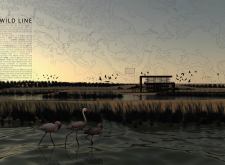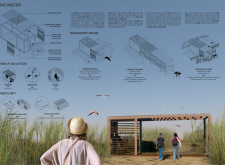5 key facts about this project
Unique Design Approaches to Nature Engagement
One of the critical aspects of the Wild Line project is its continuous ribbon-like pathway that meanders through the landscape, guiding visitors to various points of interest. This design approach allows for a seamless transition between built structures and the natural environment. The project features strategically placed observation towers that provide elevated views, enhancing the experience of observing local wildlife, particularly birds. The towers are crafted from wood and feature metal supports, ensuring minimal ecological disruption while maintaining structural integrity.
Additionally, the inclusion of various shelter units, designed to respond to different scenarios, sets the Wild Line apart. These units are categorized as 'in the sand,' 'in the water,' and 'in the bushes,' each providing distinct experiences that cater to the diverse needs of visitors. The careful consideration of placement and design underscores the project's goal of blending architecture with its context.
Functional Elements and Materiality
The functionality of the Wild Line project is closely tied to its architectural elements. The observation tower serves not only as a viewpoint but also as an educational space, inviting visitors to engage in discussions about the ecosystem. The shelters offer refuge for contemplation and relaxation, enhancing the overall visitor experience.
Materiality plays a significant role in the project's success, with a primary focus on sustainability. The prevalent use of wood not only aligns with eco-friendly standards but also creates a warm, inviting atmosphere that resonates with the natural surroundings. Metal components provide necessary structural support while ensuring minimal visual impact on the site.
The interplay of pathways, shelters, and observation areas illustrates a thoughtful approach to design, where every decision is made with careful consideration of both the ecological and user experience aspects. This project serves as a model for future architectural endeavors within sensitive environments, illustrating the potential for architecture to coexist harmoniously with nature.
For a deeper understanding of the Wild Line project's architectural plans, sections, and designs, interested readers are encouraged to explore the full presentation of the project for additional insights into its design principles and innovative approaches.


























